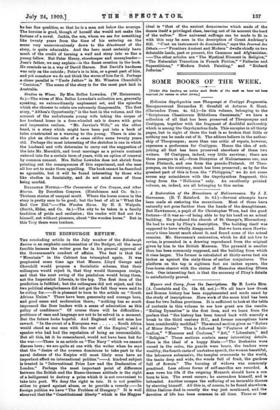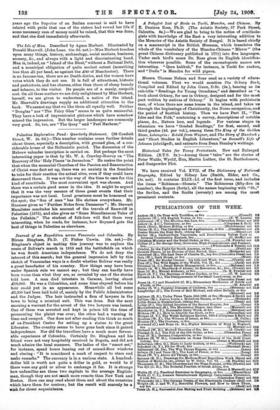Mysore and Coorg, from the Inscriptions. By B. Lewis Rice.
(A. Constable and Co. 12s. 6d. net.)—We all know how Greek and Roman history has been supplemented and made exact by the study of inscriptions. Here work of the same kind has been done for two Indian provinces. It is sufficient to look at the table of contents in this volume to see how great are the results. "Ruling Dynasties" is the first item, and we learn from the preface that "the history has been traced back with scarcely a break to the third century B.C., and former conceptions have been considerably modified." The second section gives us "Rulers of Minor States." This is followed by "Features of Adminis- tration," "Manners and Customs," "Art," "Literature," and "Religion." These sections contain many interesting details. Here is the ideal of a happy State :—" The Brahmins were versed in the vedas, the guards were brave, the traders were wealthy, the fourth caste of unshaken speech, the women beautiful, the labourers submissive, the temples ornaments to the world, the tanks deep and wide, the woods full of fruit, the gardens full of flowers." The burning of widows was commonly practised. Less odious forms of self-sacrifice are recorded. A man vows his life if the reigning Monarch should have a son born to him. The event occurs ; he surrenders himself, and is beheaded. Another escapes the suffering of an incurable disease by starving himself. All this is, of course, to be found elsewhere. Silius Italians died in exactly Use way just mentioned, and the devotion of life has been common in all time. Three or four
years ago the Superior of an Italian convent is said to have related with pride that one of the sisters had vowed her life if some necessary sum of money could be raised, that this was done, and that she died immediately afterwards.



































 Previous page
Previous page